Guest posting involves writing an article for another website, normally in exchange for a backlink.
According to the 2024 Editorial.Link report, it was the second most popular link-building tactic: 38.9% of SEO experts who participated in the study use it to build backlinks.
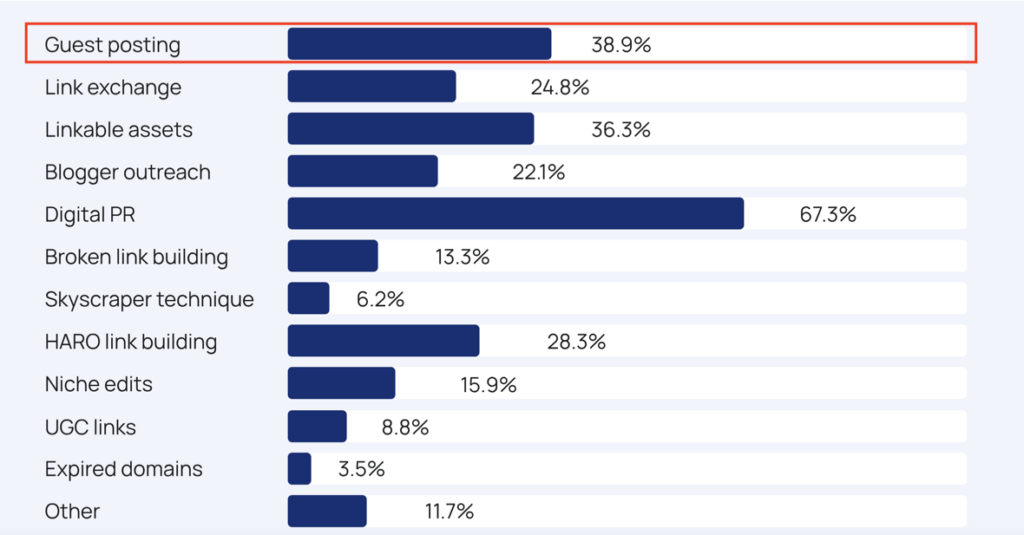
What makes it so popular?
That’s what you will find out from the article. You will also learn how to generate ideas for guest posts, pitch them and create solid guest post content.
Key takeaways
- Guest posting or guest blogging is a strategy used for link-building that involves writing and publishing articles on other websites.
- Guest posting on high-DR sites can boost your SEO with valuable backlinks.
- These links improve domain authority and drive targeted referral traffic, potentially leading to new leads and customers.
- Guest blogging exposes your brand to new audiences and establishes your authority in your field. This boosts your credibility and brand visibility.
- While guest posting is an effective strategy, it’s labor-intensive. It requires significant effort in prospecting, outreach, and content creation.
- You can find guest blogging opportunities by using specific Google search operators, researching competitor backlinks, and tracking prominent industry bloggers’ guest posts.
- Successful guest posts add value by filling content gaps or tapping into trending subjects. Use tools like Google Trends and SEO platforms to identify relevant and timely topics for the target audience.
- To increase your chances of acceptance, craft a personalized, concise, and compelling pitch that clearly outlines the value of your proposed guest post.
- Before you write your post, familiarize yourself with the guidelines. And stick to them.
- To make your posts easier to find, optimize them for search engines by embedding keywords and optimizing the text structure.
- To increase the impact of the guest post, promote it through other channels, like social media or email.
- High-quality guest posts are thoroughly researched, optimized for high readability, and provide substantial value to the reader.
- Once you get your foot in the door, make an effort to strengthen the relationship by staying in touch and engaging with the host’s content.
- Track the performance of guest posts through changes in domain metrics (DR, URLR). To attribute referral traffic to guest posts (and potential conversions), use Google Analytics with UTM parameters.
🤔 What is Guest Posting?
Guest posting, or guest blogging, is a link-building strategy. It involves writing a blog post or article for a different site. In exchange, you can normally include a link to your site. Potentially, more, for example, to your partner’s sites.
Here’s an example of a great guest blog post about session recordings by Adina Timar, a former Head of Content at Userpilot, published on the Hotjar blog.

🏆 Benefits of Guest Posting
The guest post above contains a backlink to one of Useprilot’s articles as Hotjar’s website has got pretty solid metrics (DR 92, traffic around 460k, 16.7M backlinks).
Such a link is incredibly valuable for your SEO performance. And if you’re allowed to add more links to your guest post, you can use them as 2nd tier backlinks to support your other guest posts. Or your partners’ articles, for which they hopefully reciprocate in the future.
Assuming that you secure a guest post organically, via outreach and on merit, not because you pay for it, it’s a cost-effective way to build links. And it doesn’t violate search engine guidelines.
Manual outreach is also one of the cheaper strategies since there are opportunities to gain backlinks from a simple email instead of paying for a guest post or violating Google’s guidelines and paying for a backlink.
But the SEO isn’t the only reason why guest posting is so popular.
Such backlinks don’t only pump link juice to your domain. They drive referral traffic from visitors.
Guest blogging exposes your brand to a new and relevant audience. When you publish content on popular or industry-specific sites, you introduce your brand to potential customers or followers who may not have encountered your business otherwise.
Moreover, by sharing your expertise on other websites, you can establish yourself as an authority in your field. This can enhance your credibility and increase your visibility within your industry.
Guest posts boost brand visibility and authority. Publishing content on authority sites helps present you as an expert voice, building trust and credibility. The host site is essentially endorsing you by allowing you to contribute.
Guest Posting Challenges
Compared to tactics like unlinked brand mentions, broken link building, or niche edits, guest posting isn’t the easiest way to get links. You have to earn them.
Writing a quality guest post is labor-intensive. Researching the topic, familiarizing yourself with the guidelines, and creating the content can easily take 10+ hours. Most good writers I know won’t work for less than $50 an hour. If you get 1 backlink out of it, that’s $500 a pop.
Guest posting is very competitive, so securing the opportunities requires skill and effort. And you don’t have control over the content edits or the links they add later. This can potentially dilute their value.
🔍 How to Find Opportunities for Guest Post Pitching
Here are 3 ways to find guest blogging opportunities.
Use search operator
Start looking for sites that accept guest posts with Google Search. It’s simple and free. Just type in your keyword and one of the search operators.
For example, product analytics + “write for us”

Here’s a list of more potential operators to use.

Competitor backlinks research
Your competitors’ backlink profiles are another place to look for websites in your niche that accept guest posts.
The advantage of the approach is that you don’t have to start the search from scratch. And if the accepted pitches from companies are similar to yours, they may be open to your pitch too. The downside? By targeting these sites only, you can merely match your competitors, not outperform them.
Here’s how to do it in Ahrefs, our SEO tool of choice:
1) Head to Site Explorer and type in your competitor’s domain.

2) Navigate to the Backlinks report.

3) Set the DR filter to 25-60. Getting backlinks from DR60+ sites is challenging. <25 isn’t worth it.
4) Filter by ‘blog’ in ref page URL.

5) Search the report for sites that could offer guest posting opportunities.
Our report has returned 7,925 results, so going through them one by one is just about manageable. However, it may be a bit of a grind if you have to repeat it for dozens of pages. That’s why you may want to try our next method.
Looking for bloggers in your industry
The Backlinks report doesn’t provide much information that can help you find a blog accepting guest posts. Solution? Look for websites where bloggers in your niche have guest-posted.
For example, Neil Patel is a well-known blogger in the SEO space, so look for his guest posts.
1) In Ahrefs, go to Content Explorer. In the search bar, enter topic + author:” blogger name”. Like: link building + author:"Neil Patel"

2) The report reveals the sites where Neil has posted.

3) Filter the results by DR. Neil’s website has DR91, so I set the filter for 25-88 to exclude it from the results. If you play in the same league as Neil, you’ve got a prospect list. If you’re slightly less knows, go down to 25-60, as explained above..
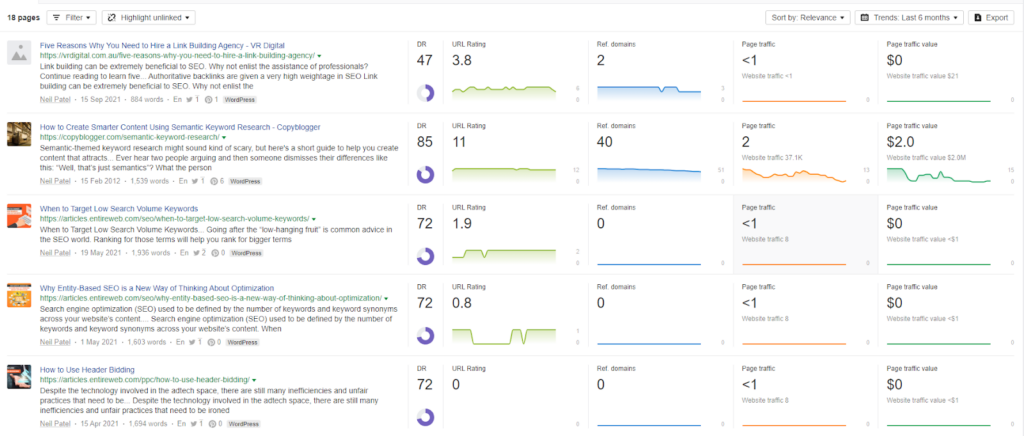
Ahrefs allows you to find the authors of blog posts on your competitors sites as well. You can find the information in the authors tab in Content Explorer.

To find them, type site:competitor URL, like, site:backlinko.com in the search bar and set the search setting to ‘Everywhere.’

How to Generate Ideas for Guest Posts
Having collated a list of prospects, it’s time to come up with blog post ideas. There are multiple approaches and techniques you can use. For best results, I recommend you use all of them.
Competitive research
For your idea to stand a chance, it needs to add value to the website. To do so, you need to analyze its content for gaps.
I analyze the existing content gap on the website. If the topic has already been covered on their website before, your guest post will be redundant and fail to add any value.
One way to do it is to target keywords that they don’t rank for but their competitors might have.
Imagine you’d like to guest post for Hotjar.
1) To identify their competitors, use the Organic competitors in Site Explorer.

2) Navigate to Competitive Analysis. Populate the search bars with your target domain and the competing domains.

3) The search returns a list of keywords your target site doesn’t rank for.
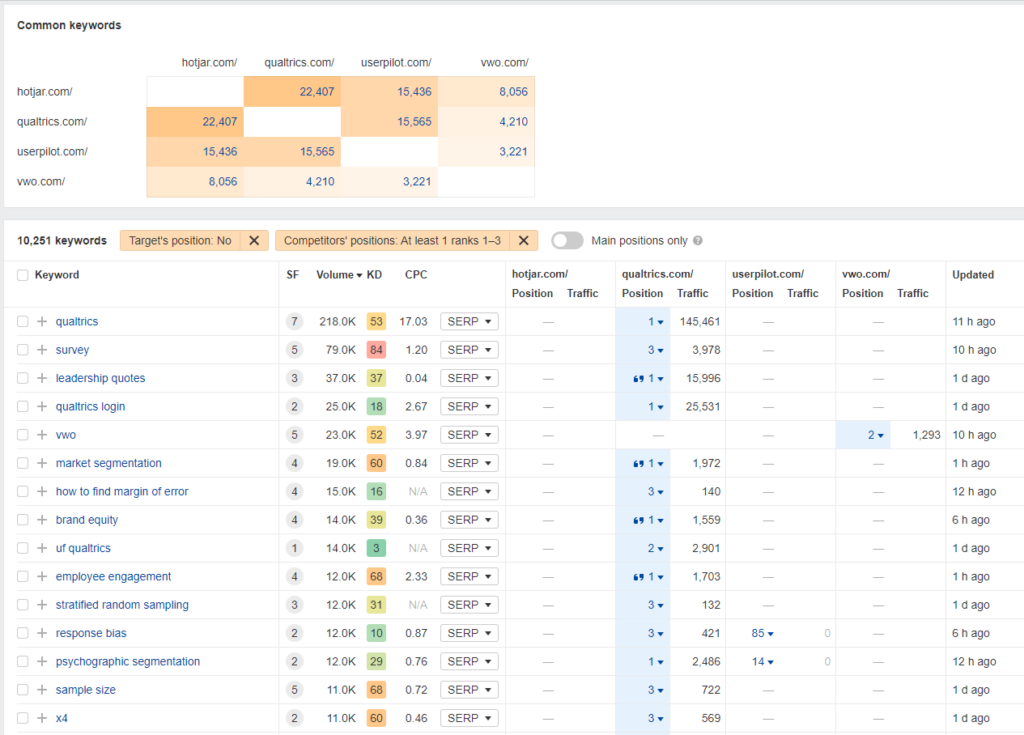
4) In the report, look for keywords that are relevant to your website’s SEO.
Follow trends
In addition to being relevant, your guest post ideas need to be fresh. So cross-reference your keyword research results with what’s trending now in your niche.
Google Trends is a simple tool for the job.

You can also use Trends to find related ideas for your content:
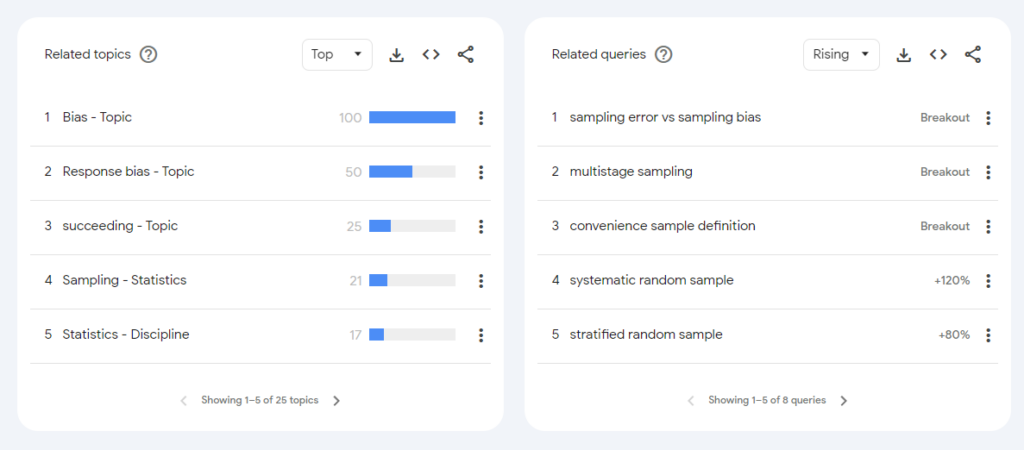
To find topics trending on social media, use tools like BuzzSumo’s Content Ideas Generator.

Use ChatGPT (AI)
An Authority Hackers study has found that 85% of marketers use AI to write articles. No surprise there. Tools like chatGPT can help you streamline all aspects of the content creation process.
Including ideation.
A simple prompt like "What are some trending topics in product analytics for a guest blog?" reveals plenty of ideas.

You then zero in on topics that could be of interest to your prospects and are relevant to your niche.
Best Practices for Guest Post Writing
Let’s wrap up with some best practices for guest posting.
Up your outreach game
Before you start writing your post, you first need to pitch your idea. That’s often easier said than done because popular blogs get dozens if not hundreds similar requests daily.
How do you increase your chances of getting a positive response?
- Write a solid subject line: include a number, ask a question, and make it 30–50 characters long.
- Personalize your email: use your first name and make a relevant reference to their content.
- Explain how your post will add value to their website: like offering a new angle on a topic, filling a content gap, or explaining your authority on the subject.
- Make the email easy to read: start with the most important information, write short paragraphs, stick to 100 words or less, use white space liberally, and add clickable links.
- Don’t faff: get straight to the point.
- Follow up: if there’s no response, try again after 2-5 days. And again. And again. Craft a unique email for every follow-up.
- Offer choice: when pitching ideas, give the site a choice of 3-4 topics to choose from.
I give three examples of blog post titles I could write based on what I’ve learned from studying their site. Do your research and pitch 3 relevant topics. You’re much more likely to get a positive response this way.
Follow the guidelines
To get your post published, follow the website’s guidelines for guest writers.
They usually include instructions on
- Tone and style
- Length
- SEO requirements
- The submission process
- Adding links to the article
Many companies, like G2, also outline their policies on plagiarism and the use of AI to ensure content integrity.
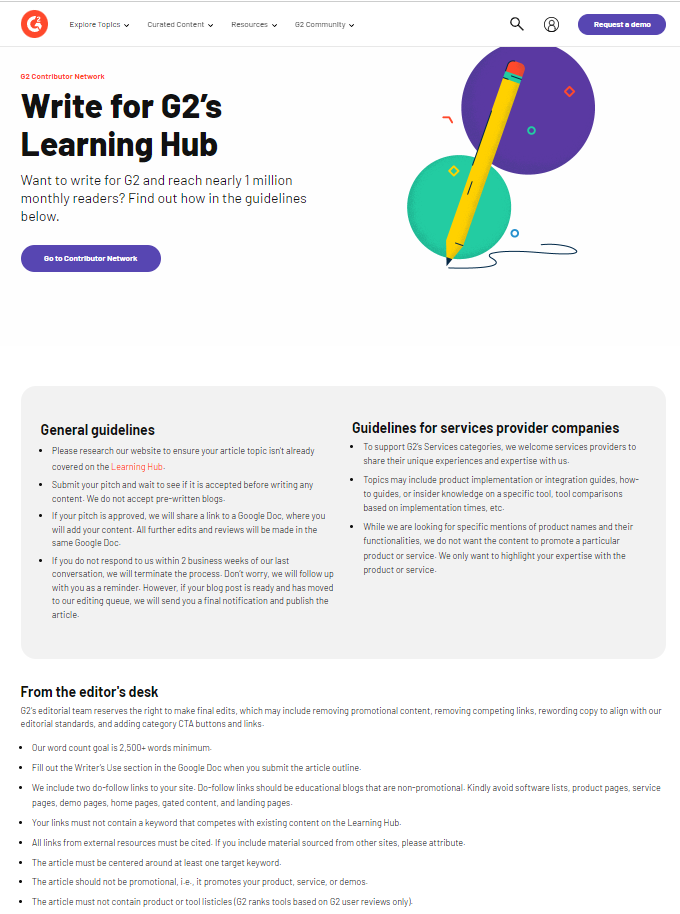
Create high-quality content
If your guest post is not top-quality, it’s not getting published. And your career as a guest poster may not last long:
My top advice is to treat guest posts as you would any other premium content asset. Thoroughly research the publication’s audience, craft content tailored to their interests, and go beyond surface-level topics to deliver substantive insights.
How do you make write solid content?
To ensure your guest posts resonate with the audience, focus on creating content that is both informative and engaging.
Start by conducting thorough research to ensure accuracy and depth in your articles.
Use credible sources to enrich the content and provide a strong foundation for your arguments or insights. Reference your sources.
If you’re not constrained by the guidelines wordcount, aim for around 1500-2500 words. It’s enough to cover the topic in enough depth while keeping users engaged.
Make your content easy to read. Use simple language and short sentences. Use link words to help the text flow.
Don’t be afraid of one-sentence paragraphs.
That’s the content your users consume via social media.

Finally, include visuals like relevant images, screenshots, or videos to break up text. Such images make the text visually appealing, help illustrate complex ideas, and act as link magnets.
Follow SEO best practices
Even though you’re not writing for your own website, optimizing your text for search engines still matters. It helps readers find it and makes your text more attractive to the website owner.
How do you do it in practice?
Use your keywords in the text. Ensure the main ones are in the title, your main headings, and the first paragraph of the text. And in the visual alt text.
Don’t overstuff the text with keywords though. Such texts read badly and are frowned upon by search engines. Just use them naturally and not at the expense of the content value.
A tool like Surfer can make the optimization process considerably easier. You enter the keyword, Surfer analyzes the SERP, and provides keyword recommendations. It also suggests the number of paragraphs, headings, and images to include.
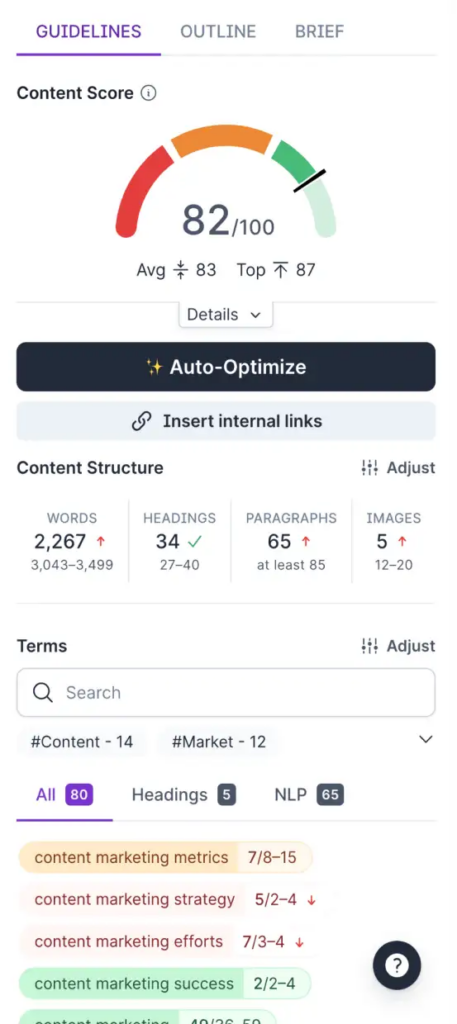
Promote the guest post
Once your guest post is published, promote it through your own channels to drive traffic and maximize its impact.
Share the post on your social media platforms, include it in your newsletters, and consider linking to it from your blog.
Encourage the host site to do the same. Their promotion can significantly amplify the reach of your content.
Consider using social media ads or collaborating with other bloggers to share your post to reach a wider audience. Especially, if they owe you a link or two.
Finally, you may also want to build links to the content to enhance its search engine performance.
Establish a relationship
Building a lasting relationship with your host site can open doors to ongoing collaboration opportunities, such as recurring guest posts or shared projects.
After your first guest post, keep in touch with the host through social media or occasional emails. Share new insights or potential ideas that might interest them.
Make sure to say hi if you’re attending industry events where they are present. Face-to-face meetings are great opportunities to strengthen your connection.
Networking with other bloggers in the host’s circle can also expand your reach and open up new platforms for guest blogging.
Track your results
When your post is finally out, track its performance to ensure that the effort put into creating it pays off.
The catch is this isn’t always easy as some of the benefits of guest-posting aren’t tangible or measurable. For example, it’s difficult to measure their impact on your brand visibility or your authority as a subject expert. Some benefits, like podcast invites, might not show for a while.
Let’s look at the things you can measure.
First, there’s your domain and URL rating. You can track them in Ahrefs.
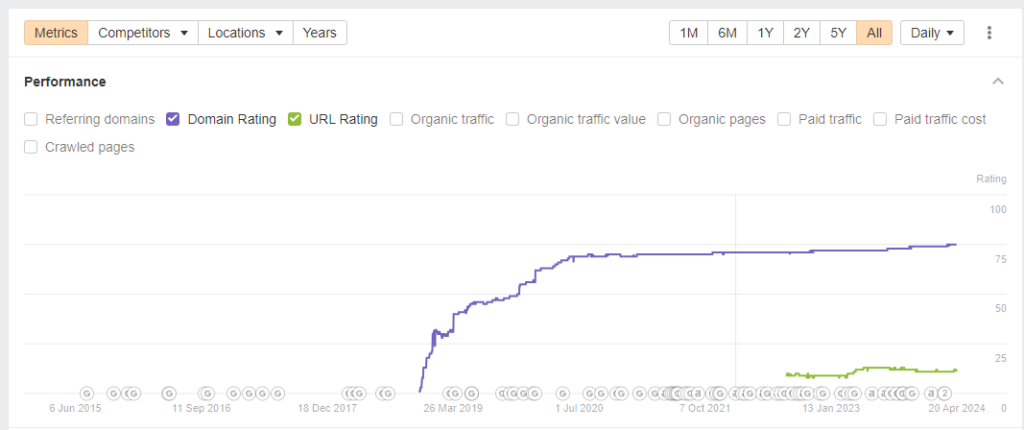
However, bear in mind that there are a lot of other factors at play, and it may be hard to attribute the results to one particular backlink.
It’s a bit easier with traffic. Although tools like Ahrefs don’t allow you to track referral traffic from specific pages, you can do it in Google Analytics through UTM.
UTM, or Urchin Tracking Module, is a text snippet added to the page URL, and it enables more accurate traffic source analysis.
Like https://www.yourwebsite.com/?utm_source=guestblog.
For example, https://editorial.link/chatgpt-link-building/your?utm_source=Hotjar
This is the link that you add to the guest post.
Final words
Guest posting is a popular marketing tactic because it doesn’t only give you backlinks and referral traffic but also exposure.
However, researching prospects, ideating attractive topics, pitching them, and creating content require time and skills. Skills that you could be putting to better use somewhere else.
That’s why you may want to hire a link-building agency to handle the process for you. If that’s what you’re considering, get in touch with the Editorial.Link team and we’ll take it from there.






